Fairfield County Show Survives Second Year
December 1st, 2012
|
Stephen White of White & White Antiques and Interiors, Skaneateles, New York, took a lot of ribbing, both from other exhibitors and a reporter, about the late Empire slant-lid desk he showed. White admitted, “This has to be the latest period slant-lid desk I’ve ever seen.” In an interesting aside, exhibitor Don Olson told us that with the advent of lightweight flat screen computer monitors he’d seen renewed interest in using those monitors on the lids of desks in home offices. The 1840-50 mahogany-veneered desk had a bird’s-eye maple interior and scrolled feet. It was tagged $1650.
Dennis and Dad Antiques, Fitzwilliam, New Hampshire, offered a variety of pottery and porcelain. On the top shelf is yellowware with mocha decoration: the pitcher at the center of the top shelf was $2750. On the bottom shelf is transfer-decorated Staffordshire, which didn’t sell well at this show but had moved nicely at the summer shows, according to Ann Berard. The lug-handled pitcher at the center of the bottom shelf originally was used to fill a footbath, Berard explained. It was $1700.
One corner of the booth of Malcolm Magruder of Millwood, Virginia, had this circa 1825 Dutch marquetry sleigh bed, in amazing condition, tagged $9500. The carved and ebonized heraldic plaque with horns above the bed is circa 1865 and was $2800.
The 14" x 24" oil on canvas by Philadelphia-based Franklin Dullin Briscoe (1844-1903) was offered by Port ‘N Starboard Gallery, Falmouth, Maine. The gallery asked $40,000 for the 1884 work titled Breezy.
Judith and James Milne of New York City brought the wonderful red-painted cupboard and shelf unit in four pieces. It’s 91" wide as seen. They asked $6800 and sold it to retail customers who plan to build it into their house. |
Norwalk, Connecticut
On December 1 and 2, 2012, Karen DiSaia and Diana Bittel presented the second Fairfield County Show in the Sono Field House in Norwalk, Connecticut. Norwalk is situated a few miles inland from the coast, about midway between Stamford and Fairfield.
The 2012 event could be called a modest success. Considering the circumstances, perhaps that should be upgraded because of the simple fact that it survived at all.
As DiSaia pointed out in a post-show conversation, “The coastal areas of Connecticut and New York were terribly hurt by Tropical Storm Sandy. Some people in Greenwich and the area around there are just getting back into their homes now, three weeks after it hit. Others had massive amounts of storm damage and now face huge bills for tree removal. Spending money at antique shows is the last thing those people impacted by Sandy want to do.”
Despite that depressing bit of news, some exhibitors still did very well, although DiSaia readily admitted others had fared less well. There may be a silver lining to the situation, though. If the pattern that prevailed after the 2011 event continues, there may be a substantial amount of post-show business.
DiSaia noted that visiting dealers were spotted leaving with substantial amounts of purchases at Saturday’s opening, and we recorded numerous sales during the hours we were on the floor, including some furniture sales.
Ann Berard of Dennis and Dad Antiques, Fitzwilliam, New Hampshire, said that unlike some of the exhibitors around them, they had a very good show and sold “lots of yellowware, including one sale of multiple pieces to a retail customer who came with her interior decorator in tow.”
As for attendance over the two-day run, Berard said, “The Sono Field House is a fairly large place to fill, what with its huge aisles. You can have a lot of people in there, and they pretty quickly disappear from view.”
The amount of inventory the Berards display at a show can be a bit daunting. “With all the boxes of ceramics we bring, we’re always both the last exhibitor to get set up and the last to get packed up and out the door,” she joked.
Another exhibitor recording a successful show was Don Olson of Rochester, New York. Olson said he takes very little furniture to shows now because of an orthopedic problem. He did OK with his other offerings though.
“If I can find smaller pieces of furniture that are up to my standards, I snap them up,” he said, “but those are getting very difficult to find now. Everyone wants stuff like that, but very little is entering the marketplace. The biggest issue I see now for a show dealer is finding good salable things.
“The business has changed so much in the last few years,” Olson added. “People who have good items are reluctant to part with them in a down-market cycle. Prices have changed dramatically. No one wants to sell things for less than they paid for them, so some owners are holding on to what they have.
“And don’t forget, the antiques market doesn’t exist in a vacuum. Our business is affected by widespread unemployment, natural disasters, and such. When people read negative reports, watch television, and pick up on the bad news, it affects the economy. People aren’t going to make buying antiques their first priority in those conditions.
“The good news is that I see a tremendous interest in antiques despite being in this bad economy. It’s just that we’re in this cycle now. I have a friend, an eighty-eight-year-old antiques dealer, and he says he’s gone through these cycles before. They always change.”
Don Olson said he goes out looking for buyable antiques almost every day. He does only four shows a year, he said, but still needs fresh stock to offer customers.
The Fairfield County Show is chock full of fine and attractive merchandise, so much so that anyone shopping it should devote more than just a cursory run-through to appreciate what’s on the floor.
It gets high marks in all categories but one (it’s a relatively expensive show for exhibitors), it has a wonderful look, and it deserves a wave of sales like the shows of yesteryear.
There’s very little Diana Bittel and Karen DiSaia can do about that. DiSaia said they could lower booth rents if the show were held in one of the off months offered by the Sono Field House people. That might result, though, in losing the customers who formerly frequented Marilyn Gould’s Wilton Holiday Antiques Show, and those are just the people the Fairfield County Show had targeted.
Show managers can advertise till their checkbooks run dry, but the struggling economy and the effects of a natural disaster are way beyond any show manager’s ability to fix. All they can do is toughen up and stick it out.
For more information, see (www.fairfieldcountyantiquesandfineart.com).
|
|
|
|
|
|
Originally published in the March 2013 issue of Maine Antique Digest. © 2013 Maine Antique Digest




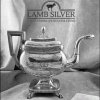








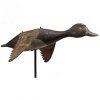



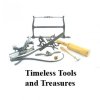
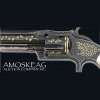


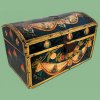















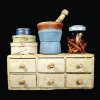



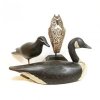








 Can you guess what this is? John Hunt Marshall of Florence, Massachusetts, had several of these sheets of steel. Knife blanks had been cut, probably with a laser, from these pieces of steel, leaving behind visually interesting patterns. This one sold within a couple of hours of opening.
Can you guess what this is? John Hunt Marshall of Florence, Massachusetts, had several of these sheets of steel. Knife blanks had been cut, probably with a laser, from these pieces of steel, leaving behind visually interesting patterns. This one sold within a couple of hours of opening. Norwoods’ Spirit of America, Timonium, Maryland, put together a very attractive booth. The fresh-to-the-market 27½" x 39" hooked rug was $2800. The Norwoods, like many others, reported that the visitors on Saturday reminded them of the early buyers at Marilyn Gould’s Wilton Holiday Antiques Show. The Norwoods did some business, but nothing like they recorded at the Vermont foliage season shows.
Norwoods’ Spirit of America, Timonium, Maryland, put together a very attractive booth. The fresh-to-the-market 27½" x 39" hooked rug was $2800. The Norwoods, like many others, reported that the visitors on Saturday reminded them of the early buyers at Marilyn Gould’s Wilton Holiday Antiques Show. The Norwoods did some business, but nothing like they recorded at the Vermont foliage season shows. A pair of 1820-30 Russian chairs (one shown) was priced at $12,500. The Louis XVI gaming table, possibly Baltic, made in the late 18th century, was $14,500. Both were offered by Gary Sergeant of Woodbury, Connecticut.
A pair of 1820-30 Russian chairs (one shown) was priced at $12,500. The Louis XVI gaming table, possibly Baltic, made in the late 18th century, was $14,500. Both were offered by Gary Sergeant of Woodbury, Connecticut.







